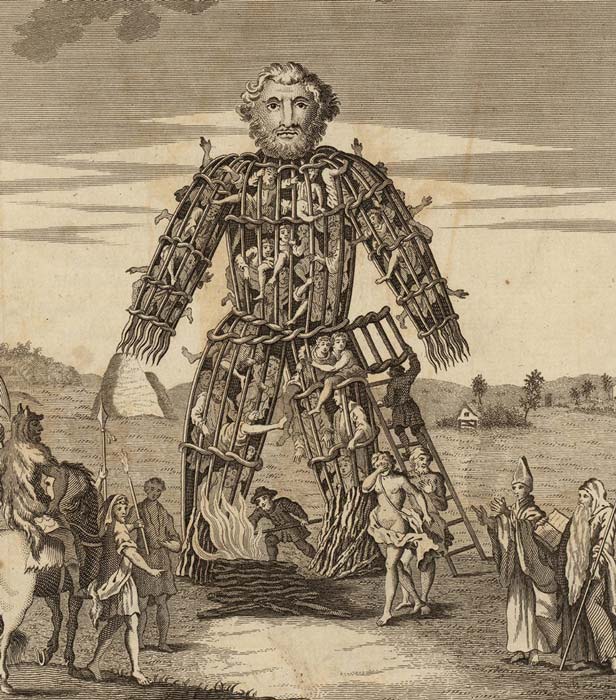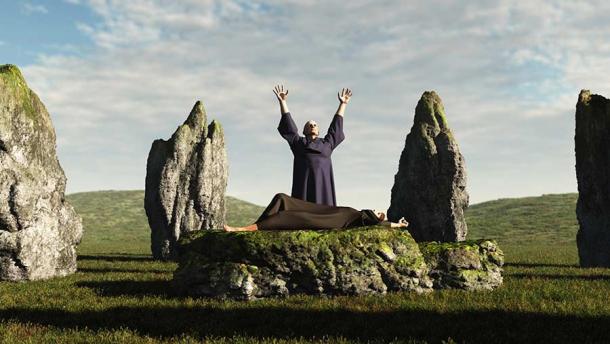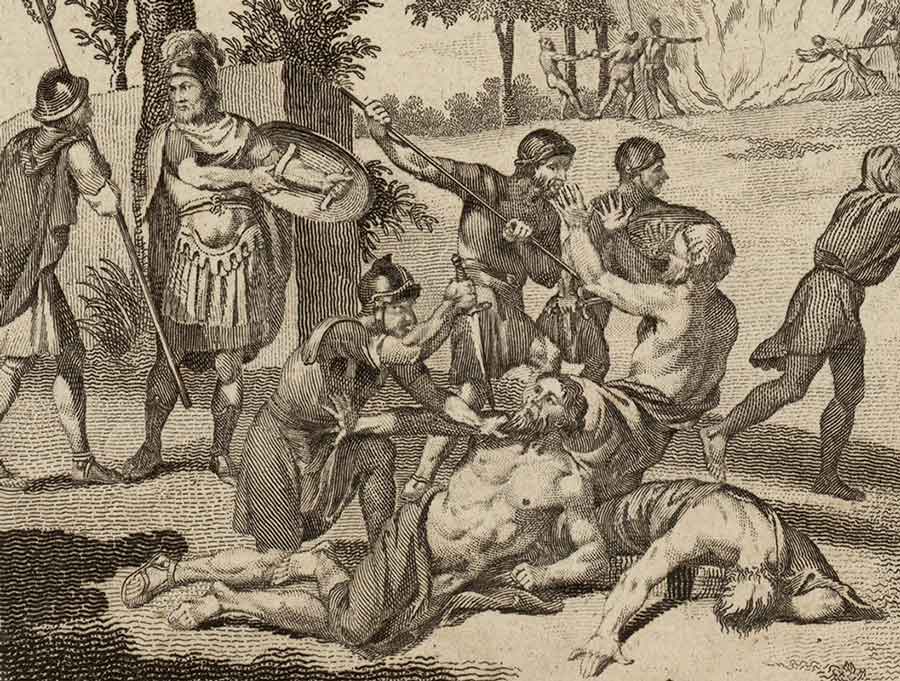The Conquest of Anglesey and the Destruction of Druidism’s Last Stronghold
With a reputation for their savagery, the destruction of the Anglesey Druids and conquest of the Welsh Isle of Anglesey by the Romans put an end to the last pagan corner of Wales in 77 AD. But was this image of savage and blood thirsty Druids just a Roman dramatization to justify their colonization in the British Isles?
The Isle of Anglesey and the Anglesey Druids
The Isle of Anglesey, or the Isle of Mona as it was known by the Romans, is a windswept island located in the northwest of Wales, bordering the Irish Sea. It is 261 square miles (675 km2), and has a series of low and fertile valleys running from the northwest to the southwest which helped it become an early grain-growing and stock-raising center. In fact, megalithic burial chambers and standing stones attest to late Neolithic and early Bronze Age habitation. By 100 BC, Celtic languages and customs had been adopted on the island, which in time became the most important Druidic stronghold in the British Isles.
To the Romans, who first encountered these native holy men during Julius Caesar’s skirmish in 55 BC, the religion, gods, and practices, including human sacrifice, were abhorrent, yet it would take over a hundred years for them to crush the sacred Druidic home and bring an end to their wicked traditions during the conquest of Anglesey.

The Isle of Anglesey in Wales from the air. (Lukassek / Adobe Stock)
Understanding the Beliefs of the Druids
“Druid” derived from the Irish word Doire which meant “oak tree” and signified the importance of nature in their belief system. Druids were polytheistic and worshipped a pantheon of natural gods that inhabited the forests, fields, and seas of their environment. They also maintained that life continued after death and the truths of reincarnation, and as such the cyclical nature of life, the seasons, light, and darkness held salient places in their worldview.
In accordance with lunar, solar, and seasonal cycles, the Druids celebrated eight holy days throughout the year. The last harvest of Yule, collected on October 31st, was revered as the Druidic New Year which would later be implemented in modern society as Halloween. At the winter solstice, on December 21st, participants would sit on mud mounds waiting for sunrise in a symbolic act of rebirth.
Imbolic on February 2nd celebrated motherhood, Belatre on April 30th fertility, and on June 21st the summer solstice would be observed as the Holly king took the place of the Oak king. Following on from this, Lughnasa on August 2nd marked the first harvest, and just before Yule would be the autumnal equinox on September 23rd.
- The Fearsome Wicker Man: An Eerie Way Druids Committed Human Sacrifice
- Mysterious Underground Labyrinth in Scotland May Have Originally Been a Druid Temple
Druidic shamans had a wide range of powers, and through their ability to contact the spiritual world were able to prescribe natural medicines, tell the future, and even induce insanity. Eschewing buildings, their dark and mystical rites were performed at temples located in forest clearings and stone circles.
Anglesey was the most important of their shrines and the educational nexus of Druidism, with acolytes’ intent on becoming fully-fledged priests taking 20 years to complete their education. There they would learn the intricacies of a complex lore which encompassed a broad array of topics such as ancient verse, natural philosophy, astronomy, and love of the gods.

An 18th-century illustration of a wicker man, a large statue which the Druids were believed by the Romans to have used for human sacrifice. Engraving from A Tour in Wales written by Thomas Pennant. (Public domain)
Relations Between the Romans and the Druids
In the Roman Empire, the Druids were primarily known for the savagery involved in their rituals and ceremonies and the variety of grisly methods used for human sacrifice. The most famous was the wicker man, where victims were tied to wooden effigies before being set alight and burnt to death. Another was the triple death, a process where the victim was strangled and drowned to near death before being stabbed.
However, Druids also had a variety of functions outside of the temple, being teachers, scientists, philosophers, and judges in equal measure. Druids were the arbiters of the British justice system, and had the power to settle private and pubic disputes, banish delinquents, and intervene in the feuds of warring chieftains to negotiate peace. There were many attractive benefits to being a Druid. They were exempt from taxation, and even female Druids commanded the same societal respect as the men from their peers, being able to fight and divorce their husbands when they wanted.
The Druidic priesthood possessed a system of hierarchy which featured an arch-Druid, resplendent in gold robes, who was acclaimed as spiritual leader. Once a year, the Druids of western Europe would gather at a sacred grove in the center of Gaul, in the territory of Carnutes, where they would settle legal quarrels and vote for another arch-Druid. Such elections were not always peaceful affairs, and it was common for Druids to decide on another leader through the medium of armed violence if they could not agree.
There were several types of more junior Druids, and their rank was denoted by the color of their robes. Ordinary Druids wore white, Sacrificers bore red, Bards were attired in blue, and new recruits sported brown and black vestments. To the Romans, the Druids represented a distortion of nature that so shocked them that their complete and utter annihilation was deemed the only appropriate response.

Roman generals and emperors closeup in the frieze of the Great Hall of the National Galleries Scotland by William Brassey Hole. (Public domain)
Roman Invasion of Britain, Leading to the Conquest of the Anglesey Druids
The lead up to the conquest of Anglesey in 59 AD involved over a hundred years of Roman attempts to assimilate Britain into the Empire. The first was in 55 BC, when Julius Caesar with two legions made the maiden voyage across the English Channel for the first foray into the mysterious British Isles.
As his fleet approached Dubris, nowadays referred to as the white cliffs of Dover, they were stunned to see a large mass of Britons brandishing spears and gathered on the edge of the cliffs. Dissuaded, the Roman general decided to land a little further up the coast at Pegwell Bay, but his visit to this strange green land was brief, with the Romans only achieving a landing and having a quick skirmish with some of the natives before returning to Gaul.
The next year, in 54 BC, Caesar attempted another invasion, this time bringing with him a significantly larger force comprising of five legions, 2,000-strong cavalry, and 27,000 men in eight ships. Unlike the first time, their landing was unopposed due to a series of political negotiations that had taken place beforehand. Mandubracius of Trinovantes, an English chieftain, had sent an embassy to Rome, promising allegiance to the Republic if they helped him restore his throne, which had been usurped by his bitter rival Cassivellaunus of Catuvellauni.
Upon arrival, Cassivellaunus, intimidated by the size of the Roman army engaged them in guerrilla warfare, relying on the mobility of 4,000 chariot fighters. Yet despite his best efforts, the Roman army was too powerful to overcome, and shortly after they crossed the River Thames the invaders captured Cassivellaunus’s capital, subduing the usurper and his subordinates quickly and restoring Mandubracius to the throne.
Between 54 BC and 43 AD, the Romans gradually increased links with their new island outpost, maintaining a power base in the southeast of Britain with the help of British elites who had gradually began to adopt Roman culture and lifestyle. Four trading routes were set up, and the wild reaches of the west and north of Britain became hunting grounds for capturing slaves.
All was well until 43 AD, when a British warlord named Caratacus embarked on a campaign of expansionism and anti-Romanism, prompting Emperor Claudius to send a force under the command of Aulus Platius to not only deal with the dangerous upstart but to further enlarge Roman territory on the island.
As Claudius’ armies moved westward towards Anglesey between 43 and 47 AD the Britons capitulated easily. Over a hundred years of Roman cultural ties had led to a tacit acceptance of Roman rule which was seen as beneficial by many of the native tribes who had developed a taste for Roman imports, culture, and conventions. It was in the second phase of this expansionism, between 47 and 60 AD, that the Romans would turn their eyes to the western reaches of the British realm, and the nightmarish lair of the Anglesey Druids.

Roman soldiers killing Anglesey Druids, as described by Tacitus. (Public domain)
The Conquest of the Anglesey Druids
When the Roman legion under Suetonius Paulinius, a commander who had distinguished himself in Armenia, approached the Penmon Peninsula on the Isle of Mona in 59 BC, terror immediately struck their hearts as the denizens of the evil isle emerged from the dark forests onto the shores:
“…a circle of Druids, lifting their hands to heaven and showering imprecations, struck the troops with such an awe at the extraordinary spectacle that, as though their limbs were paralyzed, they exposed their bodies to wounds without an attempt at movement.”
The soldiers were particularly overcome by the wildness of the women who seemed to them like representations of the most deranged of female Roman deities:
“In the style of Furies, in robes of deathly black and with disheveled hair, they brandished their torches.”
It was at this point that Paulinius had to calm his soldiers down, and rouse them to battle:
“Then, reassured by their general, and inciting each other never to flinch before a band of females and fanatics, they charged behind the standards, cut down all who met them, and enveloped the enemy in his own flames.”
What followed was an orgy of destruction as men, women, and children were struck down by the swords and spears of Rome and sacred groves and clearings were incinerated in a cataclysm of Roman fury, fired by the unholy demonstration on the beach. Although inflicting a near-lethal blow to British Druidism, the Roman legions were unable to fully complete the job, as news of Queen Boudicca’s rebellion diverted the armies back east to the imperiled settlements of Colchester and St. Albans.
After their spiritual center had been leveled, most of the surviving Druids escaped, bringing with them their totem, the Bardic Mantle, and slipping back into the obscurity of unknown Ireland, leaving only a few scattered remnants behind.
In 79 AD, following the massacre of an auxiliary squadron by the Ordovices tribes of north Wales, Gnaeus Julius Agricola, a Roman commander who had been a junior officer in the 59 AD campaign under Paulinius, finished off his superior’s work with a further invasion of Anglesey.
Employing the help of native auxiliaries who were well acquainted with the geography of the region, Agricola launched a surprise attack by ordering his subordinates to swim across the straits that separated Anglesey from the mainland:
“… he then launched them upon the enemy so suddenly that the astonished islanders, who looked for fleets of ships upon the sea, promptly came to the conclusion that nothing was hard and nothing invincible to men who fought in this fashion.”
The Druidic inhabitants were so outmaneuvered that they quickly sued for peace, bringing to an end the last pagan vestige of Wales and the conquest of Anglesey, as no further mention of disturbances on the island were ever chronicled again. Secure in the knowledge that his flank was secure, Agricola’s next task was to stamp out the defiant native tribes of the north of England.

The Druids had a reputation for human sacrifice, at least according to Roman accounts. (Algol / Adobe Stock)
Human Sacrifice: A Roman Exaggeration?
Druidic customs and practices were usually transmitted orally, and so no written record of the traditions from their perspective exists. As a result, the majority of our information comes from Roman writers and military men. Our only source for the most shocking feature of Druidism, human sacrifice, comes from Julius Caesar, who wrote how:
“The whole nation of the Gauls is greatly devoted to ritual observances and for that reason those who are smitten with the more grievous maladies and who are engaged in the peril of battle either sacrifice human victims or vow to do so, employing the Druids as ministers for such sacrifice.”
Archaeological evidence has backed this up, as bodies found at Lindow Moss attest to the existence of this gruesome custom at the same time the Romans were occupying Britain.
In reality however, human sacrifice was not as widespread in Druidism as the Romans claim. The Llyn Cerrig Bach Horde, an archaeological discovery of over 150 bronze and iron objects found in a small lake in the northwest of Anglesey, suggests that as the Romans advanced onto the island votive offerings were more commonly used to satiate the gods of nature than the souls of sacrificial victims.
It’s more likely that human sacrifice was a motif employed by the Romans to morally justify their assault on paganism, this despite the Empire itself having an equally grisly history of such executions, such as the ritual strangulation of Gallic chief Vergingetorix in the Colosseum in 46 BC.
- Stories of the Druids Abound, But What is the Hard Archaeological Evidence?
- Female Druids, the Forgotten Priestesses of the Celts
Historian Steven Rutledge has noted how it was extremely rare for Romans to attempt to eradicate an entire religion, citing the survival of the cult of Bacchus in Italy after its suppression in 186 BC and the continuation of Judaism following the destruction of Jerusalem’s temples in 70 AD. For Romans, Druidism was viewed as such a potentially dangerous vehicle of British unity that they felt the only option was to expunge it from existence, which explained the focus on human sacrifice which would justify such an act.
Nevertheless, while it took a further few years to fully pacify the southern half of Britain by 87 AD, the conquest of the Anglesey Druids, which started in 59 AD and was completed in 79 AD, represented the spiritual defeat of the rebellious Britons, who in time would be molded and shaped in Rome’s image as Druidism slowly died out. Yet its revival in the 1700s by noted literally figures such as William Blake as the Ancient Order of Druids, of which even Winston Churchill was member, attests to its enduring power in the mythology and identity of the British.
Top image: Detail of illustration showing Roman soldiers killing the Anglesey Druids, as described by Tacitus. Source: Public domain
By Jake Leigh-Howarth
References
Berry, L. A. 2021. “Who were the Druids? A history of Druidism in Britain” in British Heritage. Available at: https://britishheritage.com/history/history-druids-britain
Cross, N. 2009. “The Roman attack on Ynys Môn (Anglesey) & the British Druids” in Resources for History. Available at: https://resourcesforhistory.com/celtic_druids.htm
English Monarchs. No date. “The Last Stand of the Druids” in English Monarchs. Available at: https://www.englishmonarchs.co.uk/celts_5.html
Grigsby, P. 2021. “The Roman Invasions of Britain” in University of Warwick. Available at: https://warwick.ac.uk/fac/arts/classics/warwickclassicsnetwork/romancoventry/resources/interactions/invasion/
Johnson, B. “Who were the Druids?” in Historic UK. Available at: https://www.historic-uk.com/HistoryUK/HistoryofWales/Druids/
Roman Britain. No date. “Ynys Môn and Ynys Gybi” in Roman Britain. Available at: http://www.roman-britain.co.uk/places/mona/
Rutledge, S. H. 2007. “The Roman Destruction of Ancient Sites” in Historia. 56:2.
The Editors of Encyclopaedia Britannica. No date. “Druid: Celtic Culture” in Britannica. Available at: https://www.britannica.com/topic/Druid
The Editors of Encyclopaedia Britannica. No date. “Isle of Anglesey” in Britannica. Available at: https://www.britannica.com/place/Isle-of-Anglesey




















Comments
I think. you can argue that public executions in the colloseums of prisoners of war and criminals were a form of human sacrifice as well as the gladiator fights themselves
1) There's some evidence that some druids and went north
2)Nexus doesn't mean what you think it means
3) As pointed out, the Romans were usually tolerant of religions, however they hated human sacrifice, whether symbolic or rare. And no, Romans didn't sacrifice humans the example given was a political event, not religious.